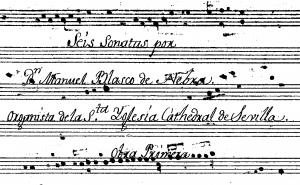Manuel Blasco de Nebra: Sonata in C minor – Adagio
Though reading this blog you might think otherwise I’m not a regular radio listener. But when I do listen it’s Klara, the Flemish classical radio station, I like most. They still have that atmosphere of awe and wonder when talking about music. In fact, that’s their slogan: “blijf verwonderd”, stay in wonder.

It was Klara who introduced me to this piece of music. To Manuel Blasco de Nebra, a Spanish keyboard player and composer. I immediately fell in love with this Adagio from the first of his 6 Sonatas opus 1.
It’s not easy to play, rather: not easy in planning one’s play: how to do justice to both the stilled reflective mood and the active majestic parts?
And then there is that first note: for a split second, a quaver, it sounds on its own before we know it is the first note of a suspension, a seufzer.
To play it in such a way that the “sighing” quality is already there even before it is revealed to be part of a suspension, that’s the art of playing music! The performer as a magician, a weaver of dreams.
Listen to the Adagio:
Manuel Blasco de Nebra (1750-1784) lived in the era where Baroque music (had) evolved into the Classicism of Haydn, Mozart.
When very roughly describing Baroque as ornamented and expressive opposed to Classicism as balanced in form and expression I hear aspects of both styles in this Sonata.
What strikes me most though is the almost random, heedless introduction of musical ideas, motives. It lacks a sense of inevitability, the sense this composition could not have been constructed otherwise.
On the contrary, it feels almost like an improvisation. And that’s exactly the charm of it!
Did Blasco de Nebra write this Sonata for harpsichord or piano? It was in the time of the transition from Baroque to Classicism that the piano was “invented”. But it took some time for it to become that most important keyboard instrument it still is today. So we’re not sure what he had in mind but if I may speak for myself: when writing a cantabile melody like the opening of this Adagio as a composer I would have been delighted with an instrument that could “sing” more than the harpsichord is able to: the piano……
or
Dag Paul, wat een heerlijke muziek van Manuel Blasco de Nebra.
Fijn om het nieuwe jaar mee te beginnen ! Wat een rust, mmmm.
Alle goeds gewenst voor 2020 en nog heel veel mooie muziek, ook voor alle andere luisteraars.
Hartelijke groet,
Elly
Dear Paul – again thank you for surprising us with a beautiful piece of piano music. I very, very much liked the Blasco de N. sonata. Well played and recorded. I was very happy that you took this composer for your next round of the Bechstein Tapes. And – as said – surprised. This because on a saturday morning end November/early december I heard B. de N. played on R4 and I was stunned by the beautiful music. I searched for hB. de N. music at the time on Spotify and found the Harmoni Mundi recordings of Javier Perianes which… Read more »
very beautiful playing Paul. Indeed a magical piece, and you make that audible.